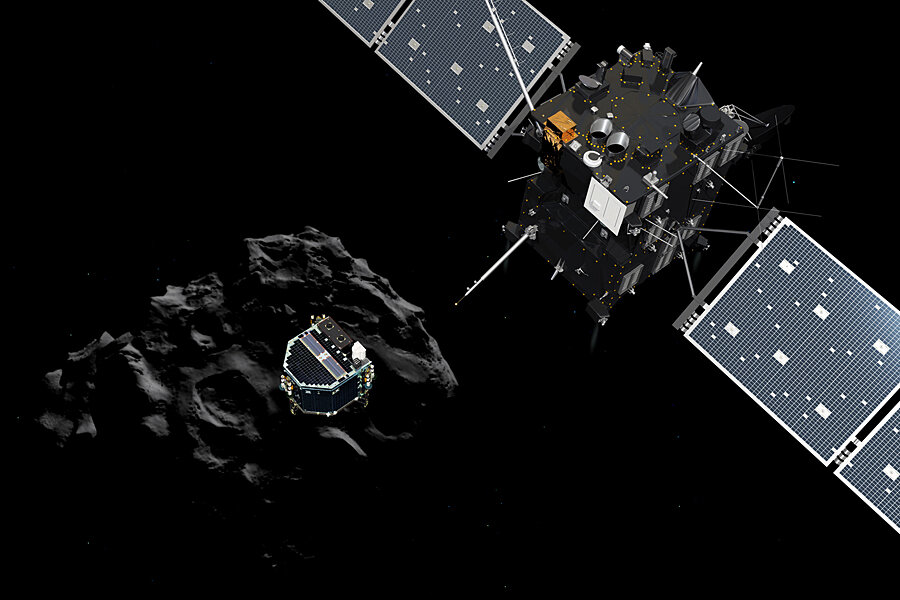Will Philae successfully land on comet? Thruster trouble heightens drama.
Loading...
A boxy lander dubbed Philae is on its way to harpoon a comet in a historic attempt to become the first spacecraft to land on a comet's rugged surface.
The lander's mother ship, the European Space Agency's Rosetta comet orbiter, released Philae at 3:35 a.m. ET for a painstakingly slow descent to 67P/Churyumov-Gerasimenko as the orbiter passed within 14 miles of the comet's surface. Touchdown is expected to occur some seven hours later.
The drama of the attempt has been heightened by the apparent loss of a thruster on top of the craft. It was designed to reduce any tendency the craft might have to bounce as it touches down on the surface of the comet, a gravitational weakling. The thruster also would be used to counteract the recoil when the craft's harpoon is shot into the surface at some 160 miles an hour. The harpoon represents the craft's ultimate anchor.
“We will need some luck not to land on a boulder or a steep slope,” said Stephan Ulamec, Philae lander manager at the DLR German Aerospace Center, via the mission's blog.
The lander is bound for a relatively flat patch on the comet, whose profile resembles a child's rubber ducky. The site is named Agilkia, for the island hosting an ancient Egyptian temple complex that is the lander's namesake.
The temple complex has an obelisk that, along with the Rosetta stone, provided the keys to translating Egyptian hieroglyphics. Solar system scientists anticipate Rosetta and Philae providing a similar service in understanding comets – icy dirt balls that along with asteroids are the construction debris left from the era when planets formed some 4.6 billion years ago.
Researchers have deposited an object on a comet before, but it was a “dumb” projectile designed to smack into comet Tempel 1 during NASA's Deep Impact mission. As the projectile's mother ship flew by the comet, it released the projectile on July 4, 2005, then analyzed the debris that the collision kicked up as a way to gather information on the comet's subsurface composition.
Delivering Philae to the comet's surface requires all the finesse of depositing a pro-football linebacker on a trampoline without a bounce.
The 220-pound lander carries instruments designed to analyze the chemical makeup of the surface and of samples that the lander's drill bring up from below the surface. Also, the lander will help the orbiter use radio signals to reveal the structure of the comet's interior. Other instruments are designed to analyze the gases the comet releases, monitor its interactions with a flow of charged particles that the sun continuously sheds as solar wind, and probe the structure of the comet's surface layers.
Yet the comet's gravity is so weak that an attempt to take a brisk walk across its surface could launch a hypothetical pedestrian back into space.
Planners have designed Philae to touch down on the surface at a speed of about two miles an hour. Its tripod-like legs are designed to absorb the shock of impact and reduce the risk of bouncing off the comet. The feet at the end of the legs have large screws designed to burrow into the surface as Philae lands to initially anchor it and keep it from slipping sideways. Once the screws are in, the lander is to launch a harpoon deep into the surface to fully anchor the craft. Once in place, flukes folded against the harpoon deploy, allowing the craft to tighten tethers connecting the anchor to the lander.
The loss of the craft's anti-bounce thruster is adding piquancy to an already agonizingly long landing sequence.
Comet 67P/Churyumov-Gerasimenko is a member of a class of comets whose orbits around the sun carry them no farther out into the solar system than the space between Mars and Jupiter. Comet 67P/Churyumov-Gerasimenko makes the trip once every 6.45 years and currently is en route for its closest approach to the sun on Aug. 13, 2015.
The Rosetta mission is designed to study the comet and the effect of a close approach to the sun on a comet's evolution as it warms to shed dust as well as gas from sublimating ices.
[Editor's note: The original version of this story did not state the correct number of harpoons, which is one.]






